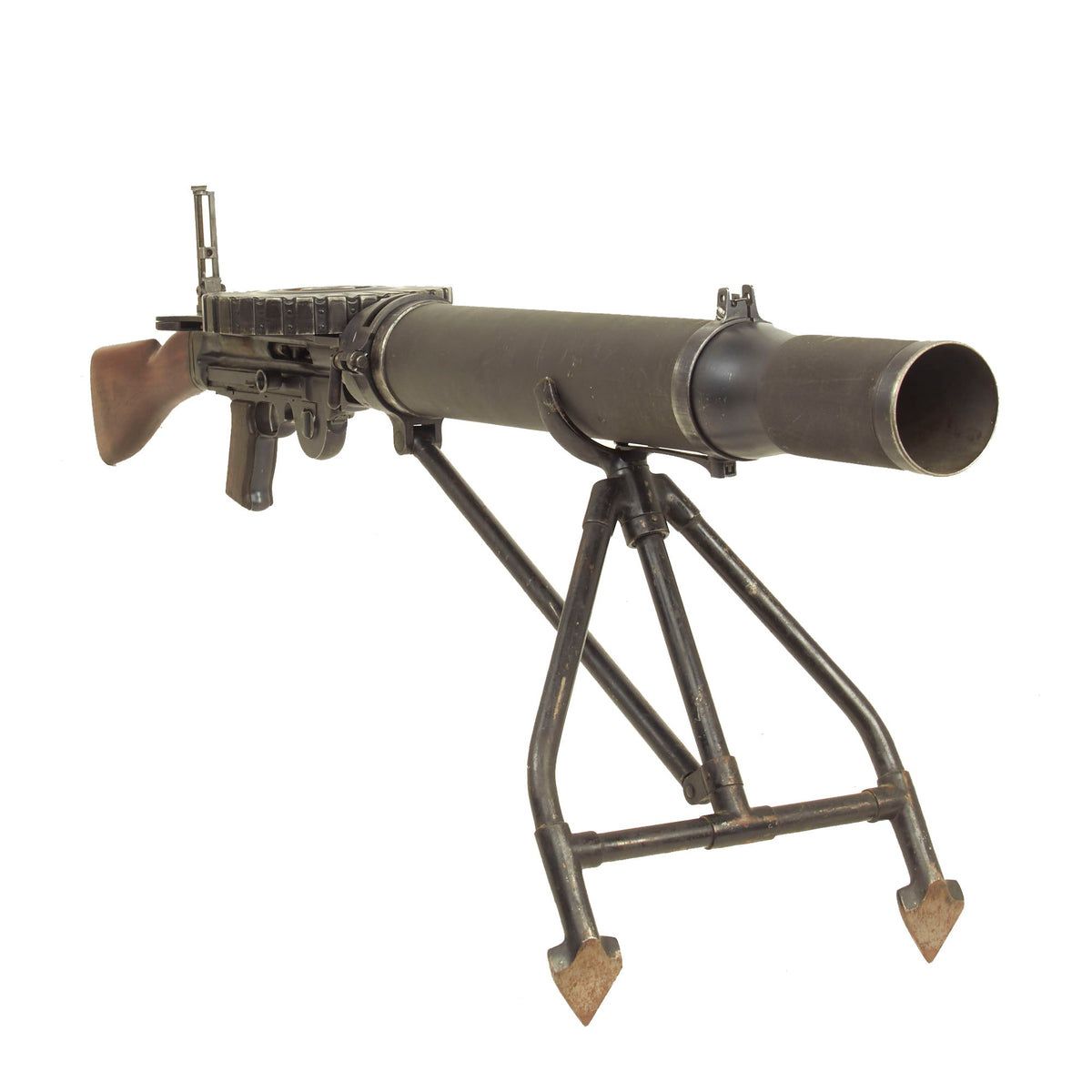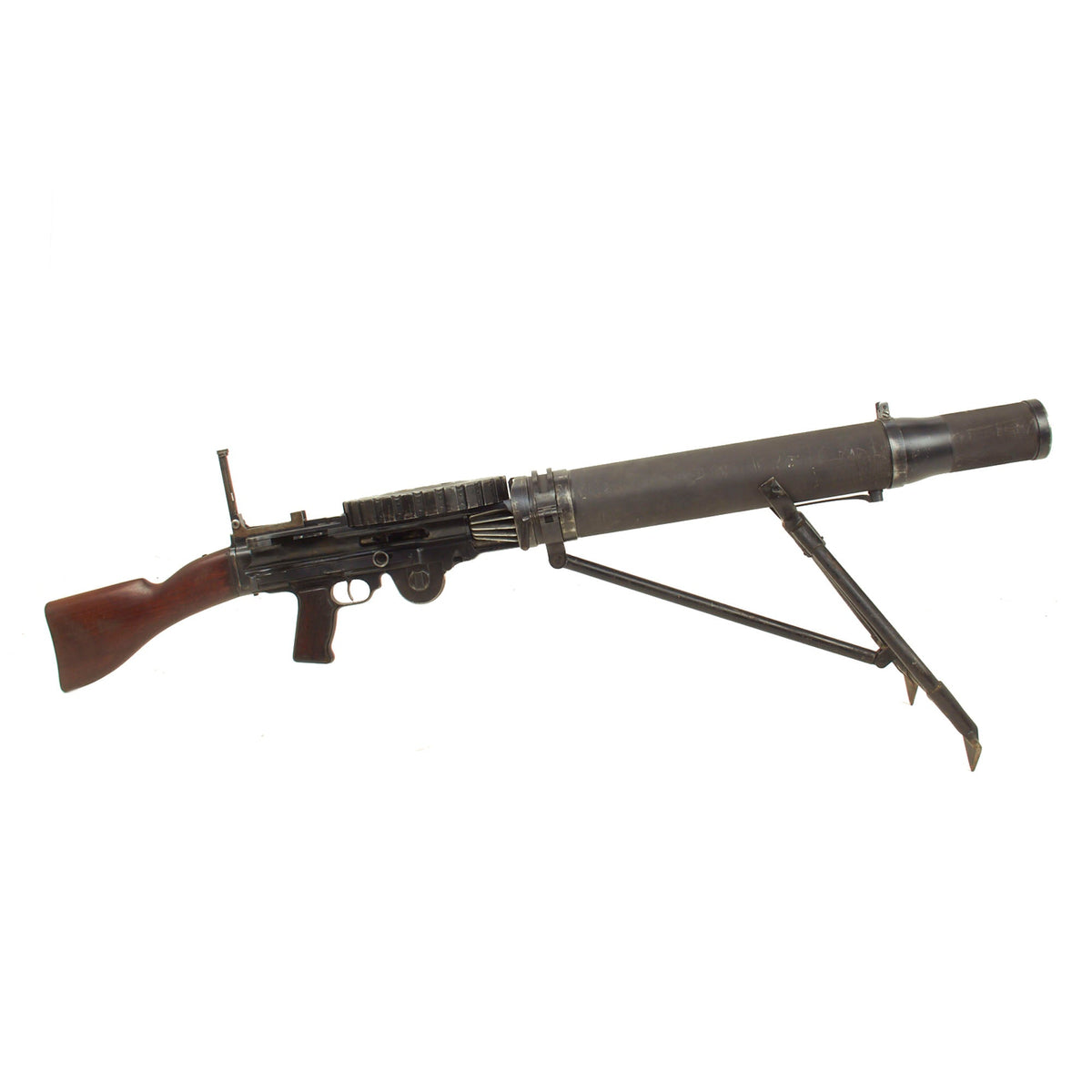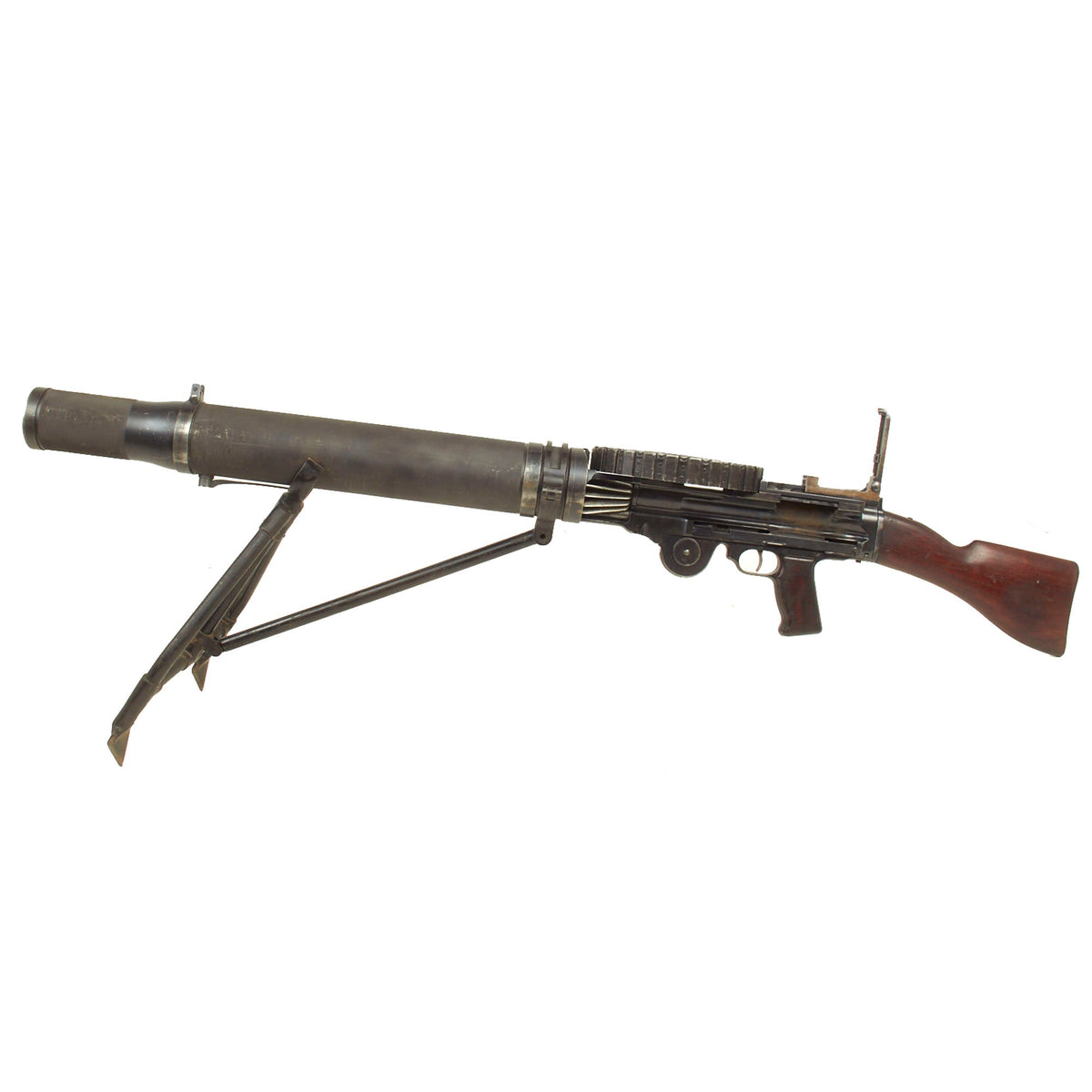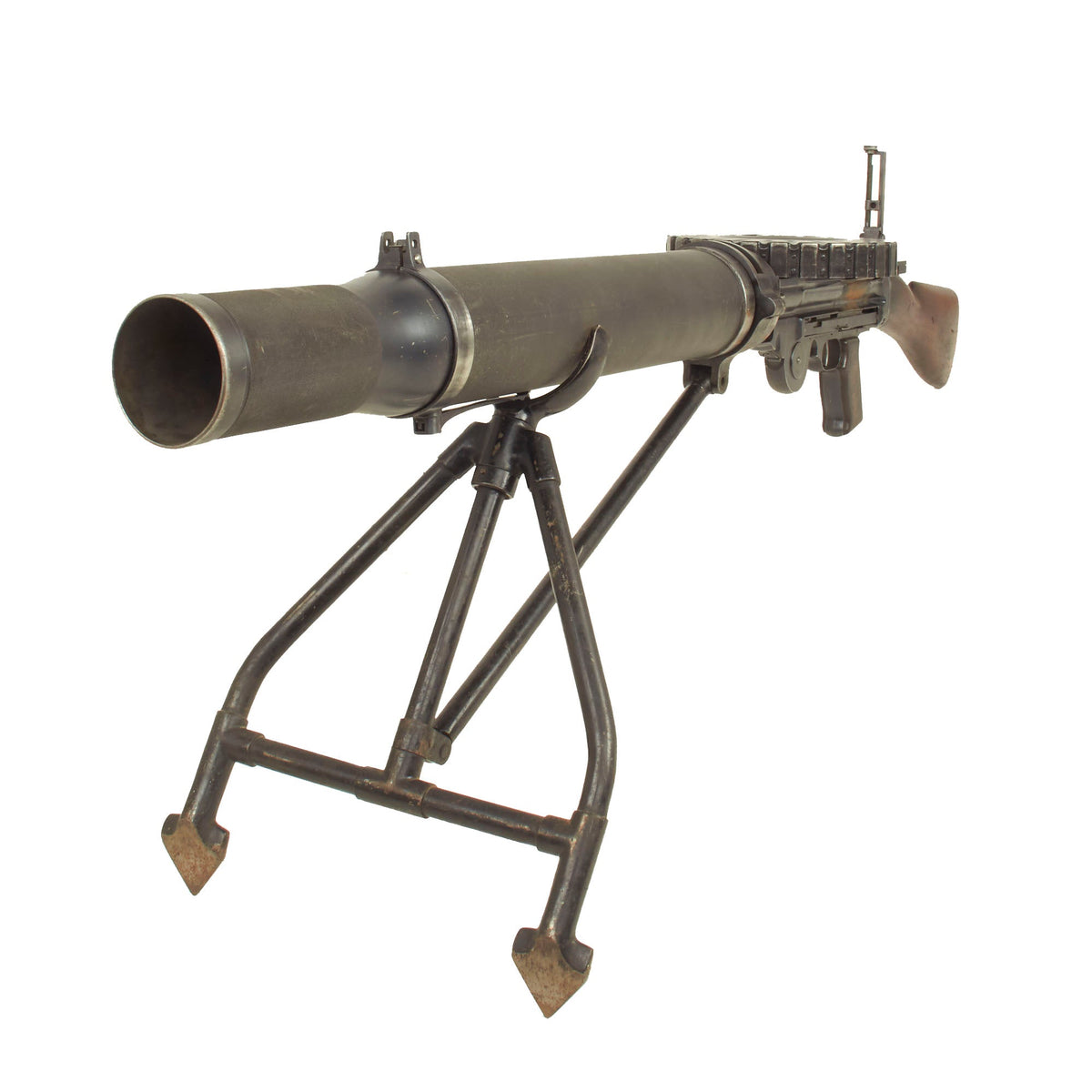Original British WWI U.S. Made Savage .303 Lewis Gun Display Light Machine Gun with Field Mount Original Items
$ 8.495,00 $ 2.123,75
Original Item: One-of-a-Kind. This is a fantastic example of an exceedingly rare WWI Savage Commercial Lewis Display Light Machine Gun in .303 British caliber, as used by both British and Canadian forces during the war.
This non-firing display gun was constructed from excellent genuine WWI parts and reassembled using a torch cut BATF complaint severed receiver. This is a 100% legal inert machine gun. This receiver was created by using portions of the original severed torch cut receiver, including the barrel bushing, combined with newly made solid steel section. It has properly had a 25% section (3.5 inches) of the total length completely replaced with solid steel bar stock. Meaning a 1/4 length section of the display receiver is solid steel and therefore legal to own without a license of any kind. Every part on this display gun is original WWI manufacture other than the portions of solid steel replaced in the receiver (as mandated by BATF).
When the U.S. entered WWI, Savage Arms Corporation of Utica, NY began production of the weapon, mainly for use by U.S. forces. It was not officially adopted for ground use by the U.S. Army, however the U.S. Navy did use the gun in the standard M1917 configuration, as well as the M1918 Aircraft variant produced by Savage. These guns were for the most part identical to the British versions produced by B.S.A., but they were chambered for the U.S. .30-06 rimless cartridge, instead of the British .303 rimmed cartridge. The U.S. also supplied the British with .30-06 chambered Lewis guns after they entered the war, which were referred to by a different model number to avoid confusion.
Even with this, total U.S. production of the Lewis Gun was only a fraction of the 145,000 produced by B.S.A. in England. However in this small number, Savage did make a small number of Lewis Guns chambered for .303, which were utilized by Canadian and British Forces. We believe this is a Commercial .303 example that was used by Canada, as under the magazine pan there are some British style markings, and what looks to be a Broad Arrow in C Canadian Proof.
This example is in excellent condition, and we believe it most likely was never shipped off to Europe, instead remaining in North America as a production sample, possibly because it was made too late. It still has clear original production markings at the top of the receiver under the magazine, which read:
LEWIS MACHINE GUN
MFG. BY SAVAGE ARMS CO.
UTICA. NY. U.S.A.
No. 2936
To the left of this is what we believe is the Canadian “Broad Arrow in C” marking, and to the right is a British style proof mark. It is also marked just under the magazine feed mechanism with:
LEWIS MACHINE GUN
MFG. BY SAVAGE ARMS C. UTICA. NY. U.S.A.
Under this is the “Savage Quality” Native American trademark. The rear sight is correctly marked .303 MkVII, so it has the correct ranges for the lower powered .303 British rounds. There is also no “.30 U.S. GOV’T.” marking indicating that the gun was made for .30-06, as is correct.
A huge number of patent markings can be found on the back of the butt plate. The display gun comes complete with an original British Lewis Gun 47 round magazine .303 Mk.VI & VIII, which has the correct proof marks and looks to be fully functional. It can still be mounted on the gun and even rotated around. Also included is a fantastic rigid field mount, which is marked with the Savage SACo marking. It is in very good condition, and is extremely rare, really adding to the piece.
A fantastic and exceedingly rare Lewis Gun variant, in magnificent condition. We have never had a Lewis gun offering like this before, and it is unlikely that we will again!
The Lewis gun (or Lewis automatic machine gun or Lewis automatic rifle) is a First World War–era light machine gun. Designed privately in the United States though not adopted there, the design was finalized and mass-produced in the United Kingdom, and widely used by troops of the British Empire during the war. It had a distinctive barrel cooling shroud (containing a finned, aluminum breech-to-muzzle heat sink to cool the gun barrel) and top-mounted pan magazine. The Lewis served to the end of the Korean War, and was widely used as an aircraft machine gun during both World Wars, almost always with the cooling shroud removed, as air flow during flight offered sufficient cooling.
A predecessor to the Lewis gun incorporating the principles upon which it was based was designed by Ferdinand Mannlicher. The Lewis gun was invented by U.S. Army colonel Isaac Newton Lewis in 1911, based on initial work by Samuel Maclean. Despite its origins, the Lewis gun was not initially adopted by the U.S. military, most likely because of political differences between Lewis and General William Crozier, the chief of the Ordnance Department. Lewis became frustrated with trying to persuade the U.S. Army to adopt his design, claiming that he was “slapped by rejections from ignorant hacks”, and retired from the army.
Lewis left the United States in 1913 and went to Belgium, where he established the Armes Automatique Lewis company in Liège to facilitate commercial production of the gun. Lewis had been working closely with British arms manufacturer the Birmingham Small Arms Company Limited (BSA) in an effort to overcome some of the production difficulties of the weapon. The Belgians bought a small number of Lewis guns in 1913, using the .303 British round and, in 1914, BSA purchased a license to manufacture the Lewis machine gun in England, which resulted in Lewis receiving significant royalty payments and becoming very wealthy. Lewis and his factory moved to England before 1914, away from possible seizure in the event of a German invasion.
The onset of the First World War increased demand for the Lewis gun, and BSA began production, under the designation “Model 1914”. The design was officially approved for service on 15 October 1915 under the designation “Gun, Lewis, .303-cal.” No Lewis guns were produced in Belgium during the war; all manufacture was carried out by BSA in England and the Savage Arms Company in the US.
The first use of the Lewis in the war was by Belgium, in August and September 1914, when the small number available were fitted to a handful of touring and armored cars and used in a few sorties against German patrols and troop columns. As a consequence, the Germans are supposed to have nicknamed the Lewis “the Belgian Rattlesnake”, although contemporary German references confirming this have not been found. The Lewis was not in service with the regular Belgian Army.
The United Kingdom officially adopted the Lewis gun in .303 British caliber for land and aircraft use in October 1915, with the weapon beginning to be generally issued to the British Army’s infantry battalions on the Western Front in early 1916 as a replacement for the heavier and less mobile Vickers machine gun, the Vickers then being withdrawn from the infantry for use by specialist machine-gun companies. The US Navy and Marine Corps followed in early 1917, adopting the M1917 Lewis gun (produced by the Savage Arms Co.), in .30-06 caliber.
The US Army never officially adopted the weapon for infantry use and even went so far as to take Lewis guns away from US Marines arriving in France and replace them with the cheap, shoddy, and extremely unsatisfactory Chauchat LMG—a practice believed to be related to General Crozier’s dislike of Lewis and his gun. The US Army eventually adopted the Browning Automatic Rifle in 1917 (although it was September 1918 before any of the new guns reached the front). The US Navy and Marine Corps continued to use the .30-06 calibre Lewis until the early part of the Second World War.
Fast Shipping with Professional Packaging
Thanks to our longstanding association with UPS FedEx DHL, and other major international carriers, we are able to provide a range of shipping options. Our warehouse staff is expertly trained and will wrap your products according to our exact and precise specifications. Prior to shipping, your goods will be thoroughly examined and securely secured. We ship to thousands clients each day across multiple countries. This shows how we're dedicated to be the largest retailer on the internet. Warehouses and distribution centres can be located throughout Europe as well as the USA.
Note: Orders with more than one item will be assigned a processing date depending on the item.
Before shipping before shipping, we'll conduct a thorough inspection of the items you have ordered. Today, the majority of orders will be delivered within 48 hours. The delivery time will be between 3-7 days.
Returns
The stock is dynamic and we cannot completely manage it because multiple stakeholders are involved, including our factory and warehouse. So the actual stock may alter at any time. It's possible that you may not receive your order once the order has been made.
Our policy is valid for a period of 30 days. If you don't receive the product within 30 days, we are not able to issue a refund or an exchange.
You can only return an item if it is unused and in the same state as the day you received it. You must have the item in its original packaging.
Related products
Uncategorized
Uncategorized
Uncategorized
Uncategorized
Uncategorized
Uncategorized
Uncategorized
Uncategorized
Band of Brothers ORIGINAL GERMAN WWII Le. F.H. 18 10.5cm ARTILLERY PIECE Original Items
Uncategorized
Uncategorized
Uncategorized
Uncategorized
Uncategorized
Uncategorized
Australian WWII Owen MK1 Machine Carbine SMG Custom Fabricated Replica with Sling Original Items
Uncategorized
Uncategorized
Uncategorized
Uncategorized













































































